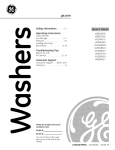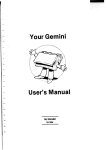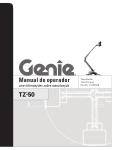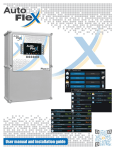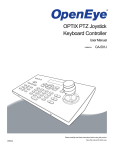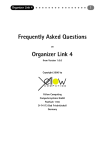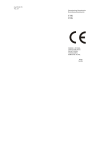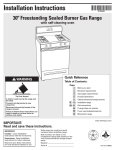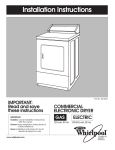Download Whirlpool 3406449 Service manual
Transcript
COIII II I It:fcial 27” Electronic Dryer --AI 1M PORTANT: Part No. 3406449 Your safety and the safety of others is very important. Ne have provided many important safety messages in this manual and In your appliance. Always read and 3bey all safety messages. q! This is the safety alert symbol. This symbol alerts you to hazards that can kill 3r hurt you and others. All safety messages will be preceded by the safety alert symbol and the word “DANGER” or “WARNING”. These words mean: Read and save these instructions. Important: Read these instructions before you start to install the dryer. Save Installation Instructions for local electrical inspector’s use. Keep Installation Instructions for future reference. Before you start... Check location where dryer will be used. Proper installation is your responsibility The dryer must not be installed or stored in an area where it will be exposed to water and/or weather. Make sure you hove everything necessary for correct installation. The dryer is equipped with an electronic control timer, selector switches and indicator lights. The timer is set to provide 45 minutes of drying time when activated. All safety messages will identify the hazard, tell you how to reduce the chance of injury, and tell you what can happen if the instructions are not followed. odiustable wrench utility knife Phillips screwdriver flat-blade screwdriver gloves solely glasses level pliers duct tape Parts supplied: 4 leveling legs Parts owner must supply: For electronic system support (cards and additional electronic features), contact: IntelliCard Systems Ltd. 1520 Neptune Dr. Boynton Beach, FL 33426 You &l be killed or seriously injured if you don’t follow instructions. You can be killed or seriously injured if you don’t follow instructions. Tools needed for instaIIation: (407) 369-3435 Explosion Hazard Keep flammable materials and vapors away from dryer. Place dryer at least 18 inches above the floor for a garage installation. Failure to do so can result in death, explosion, fire, or burns. It is the customer’s responsibility: -To contact a qualified electrical installer. -To have dryers installed according national and local codes and ordinances. to al a-w Exhaust requirements Use duct tape to seal all joints. exhaust airflow f/ I Aa Fire Hazard Use a heavy metal vent. Do not use a plastic vent. Do not use a metal foil vent. Failure to do so can result in death or fire. Do not use non-metal flexible vent, metal vent that is smaller than four inches in diameter or exhaust hoods with magnetic latches. Do not exhaust dryer into a chimney, furnace cold air vent, al-tic of crawl space, or any other vent used for venting. Do not install flexible vent in enclosed walls, ceilings or floors. If using an existing exhaust system, clear lint from entire length of exhaust system Make sure exhaust hood is not plugged with lint. The exhaust system should be inspectec and cleaned yearly. Replace any vinyl or metallized plastic foil exhaust vent with rigid metal or flexible metal vent. vent is reql lired. Plan installation to use the fewest number of elbows and turns. Four-inch metal exhaust Metal flexible vent must be fully extended and supported when the dryer is in its final position. DO NOT KINK OR CRUSH THE VENT. The metal flexible vent must be completely open to allow adequate exhaust air to flow. Allow as much room as possible when using elbows or making turns. Bend vent gradually to avoid kinking. Remove excess flexible vent to avoid sagging and kinking that may result in reduced air flow. Exhaust outlet is located at the center of the bottom dryer back. The exhaust vent can be routed up, down, left, right, behind the dryer or straight out the back of the dryer. Kits are available to convert the exhaust vent to be routed through the cabinet right or left side or through the bottom. See Page 3 for Exhaust Kit part numbers. See Page 11 for product dimensions and recessed area requirements. Maximum length of exhaust system depends upon the type of vent used, number of elbows and type of exhaust hood. The maximum length for both rigid and flexible vent is shown in the chart. I I I I DIAMETER RIGID METAL VENT 0 43 n. 1 33 ft. 41 ft. 31 Fr. 21 ft. 2 0 1 2 ii it. LENGTH OF 4-INCH 30 ft. 24 ft. 16ft. DIAMETER 29 ft. 23 ft. 15 n. 36 f-t. 26 ft. 16 ft. FLEXIBLE METAL VEN 24 ft. 18 n. 10 n. For exhaust systems not covered by the exhaust length chart, see Whirloool Service Manual, “Exhausting Whirlpool Dryers,” Part No. 603197, Page 2 A main exhaust vent can be used for exhausting a group of dryers. Main exhaust vent should be sized to remove 200 CFM of air per dryer. Large-capacity lint screens of proper design may be used in the main exhaust vent if checked and cleaned frequently. The room where the dryers are located should have make-up air equal to or greater than the CFM of all the dryers in the room. I LENGTH OF 4-INCH MAXIMUM Four-inch outlet hood is preferred. However, a 2-l/2-inch outlet exhaust hood may be used. A 2-l/2-inch outlet creates greater back pressure than other hood types. For permanent installation, a stationary exhaust system is required. EXHAUST HOOD TYPE I MAXIMUM available from your Whirlpool parts distributor. Service check: The back pressure in any exhaust system must not exceed 0.6 inches of water column measured with an inclined manometer at the point that the exhaust vent connects to the dryer. Exhausting the electric dryer outside is recommended. A closet installation must be exhausted outside. Recessed installation that is not exhausted outside must use Exhaust Deflector, Part No. 3391278 (electric dryer only), available from your dealer. If dryer is installed in a confined area, such as a bedroom, bathroom or closet, it must be exhausted to the outside and provision made for enough air for combustion and ventilation. (Check governing codes and ordinances.) See “Recessed area and closet installation instructions” on Page 11. An exhaust hood should cap the exhaust vent to prevent exhausted air from returning into the dryer. The outlet of the hood must be at least 12 inches from the ground or anything else that may be in the path of the exhaust. Back-draft Damper Kits, Part No. 3391910, are available from your Whirlpool dealer and should be installed in each dryer’s exhaust vent to prevent exhausted air from returning into the dryers and to keep the exhaust in balance within the main exhaust vent. Unobstructed air openings are required. Each exh’aust vent should enter the main vent at an angle pointing in the direction of the aitilow. Vents entering from the opposite side should be staggered to reduce the exhausted air from interfering with the other vents. The maximum angle of each vent entering the main vent should be no more than 30”. Keep air openings free of dry cleaning fluid fumes. Fumes create acids which, when drawn through the dryer heating units, can damage dryers and loads being dried. Exhaust vent connection Determine which direction you need to attach the exhaust vent to the dryer. Next, determine the length of the exhaust vent you will need to connect the dryer to exhaust hood or main vent. To connect exhaust vent straight out the back - A clean-out cover should be located on the main exhaust vent for periodically cleaning the exhaust system. An exhaust hood should cap the outside end of the main vent to prevent exhausted air from returning to the dryers If an exhaust hood cannot be used, the outside end of the main vent should have a sweep elbow directed downward. If the main vent travels vertically through the roof, rather than through the wall, install 180” sweep elbow on the end of vent at least 2 feet above the highest part of the building. The opening wall or roof shall have a diameter l/2 inch larger than the exhaust vent diameter. The exhaust vent should be centered in the opening. Attach exhaust vent to dryer vent. Then connect exhaust vent to exhaust hood or main exhaust vent Use duct tape to seat all joints. This dryer may be converted to be exhausted out the right or left side or through the bottom. To convert the dryer, one of the following kits MUST be used: Exhaust Kit No. 279818 (White) Exhaust Kit No. 279819 (Almond) Follow the instructions in the kit to avoid operational and personal hazard. exhaust hood or l-l R- WOII 180” 2 ft. min. above highest point of collector Do Not install screening end of vent. or cap over vent Gas supply requirements WARNING: If the information in this manual is not followed exactly, a fire or explosion may result causing property damage, personal injury or death. - Do not store or use gasoline, or other flammable vapors and liquids in the vicinity of this or any other appliance. - WHATTO DOIF YOUSMELL GAS: l Do not try to light any appliance. l Do not touch any electrical switch; Do noi use any phone in your building. l Immediately call your gas supplier from a neighbor’s phone. Follow gas supplier’s instructions. l If you cannot reach your gas supplier, call the firt department. - Installation and service must be done by a qualified installer, service agency or the gas supplier. Observe all governing ordinances. codes and Post this warning in a prominent location. It is recommended that the operator post, in a prominent location, instructions for the customer’s use in the event the customer smells gas. This information should be obtained from your local gas supplier. Page 3 must be done by a qualified service technician. Gas conversion kit part numbers are listed on the gas valve burner base. hk n Provide a rigid gas supply line of l/2-inch IPS pipe to the dryer location, If the total length of the supply line is more than 20 feet, larger pipe will be needed. For L.P gas usage, 3/8-inch, approved copper tubing may be used. Pipe-joint compounds suitable for use with L.P gas should be used. Explosion Hazard Connect dryer to a regulated gas supply. Use a new flexible gas supply line. If L.P. gas is used, the L.P. gas supply must not exceed 13” water column. Failure to do so can result in death, explosion, or fire. A with F This installation must conform American National Standard, National Fuel Gas Code ANSI 2223.1 -latest edition (*, Page 5) and all local codes and ordinances. n n If local codes and ordinances permit, it is recommended that new, flexible metal tubing, design-certified by the American Gas Association, be used for connecting the dryer to the gas supply line. (The gas feed pipe, which extends through the lower rear of the dryer, is provided with 3/8-inch male pipe thread.) dryer C Checkwiththatthethecorrect equipped is burner for the particular type of gas used. Burner information can be found on the model/serial rating plate in the door well of the appliance. If this information does not agree with the type of gas available, see your dealer. n D . This dryer is equipped for use with NATURAL GAS. it is certified by the American Gas Association for manufactured, mixed and L.P (propane and butane) gases with appropriate conversion. No attempt shall be made to convert the appliance from the gas specified on the model/serial rating plate for use with a different gas without consulting the serving gas supplier. Conversion Page 4 --- Electrical requirements shutoff valve B . The design of this dryer has been certified-by the American Gas Association for use at altitudes up to 10,000 feet above sea level at the B.T.U. rating indicated on the model/serial rating plate. Burner input adjustments are not required when the dryer is operated up to this elevation. When installed above 10,000 feet, a four percent (4%) reduction of the burner B.T.U. rating shown on the model/serial rating plate is required for each 1,000 foot increase in elevation. For assistance when converting to other gas types and/or installing above 10,000 feet elevation, contact your local service company. valve must be disconnected from the gas supply piping system during any pressure testing of that system at test pressures in excess of l/2 psig (3.4 kPa). The dryer must be isolated from the gas supply piping system by closing the individual manual shutoff valve during any pressure testing of the gas supply piping system at test pressures equal to or less than l/2 psig (3.4 kPa). G WThe supplv line shall be equipped with ‘a shutoff valve. This valve should be located in the same room as the dryer and should be in a location that allows ease of opening and closing. Do Not block access to the shutoff valve. H If rigyd pipe is used as a ga combination must be used to’dbtain a: in-line connection to the dryer. I n Make sure that lower edges of the cabinet, plus the back and bottom sides of the dryer are free of obstructions to permit adequate clearance of air openings for combustion air, See “Recessed area and closet installation instructions,” on Page 11, for minimum spacing requirements. J n For ease of installation, operation and servicing (if ever needed) adequate space should be provided around the dryer. K n A 1/&inch, NPT plugged tapping, accessible for test gauge connection, must be installed immediately upstream of the gas supply connector to the dryer. The dryer and its individual shutoff Electrical Shock Hazard Plug into a grounded 3-prong outlet. Do not remove ground prong. Do not use an adapter. Do not use an extension cord. Failure to follow these instructions can result in death, fire, or electrical shock. If codes permit and a separate ground wire is used, it is recommended that a qualified electrician determine that the ground path is adequate. Observe all governing codes and ordinances. A 120-volt, 60-Hz, AC-only, 15 or 20-ampere fused electrical supply is required. A time-delay fuse or circuit breaker is recommended. It is recommended that a separate circuit serving only this appliance be provided. Recommended method ground For your personal safety, this dryer must be grounded. This dryer is equipped with a power supply cord having a 3-prong ground plug. To minimize possible shock hazard, the cord must be plugged into a mating 3-prong ground-type wall receptacle, grounded in accordance with National Electrical Code ANSVNFPA 70 - latest edition (**, Page 5) and all local codes and ordinances. If a mating wall receptacle is not available, it is the personal responsibility and obligation of the customer to have a properly grounded, 3-prong wall receptacle installed by a qualified electrician. Figure 1. See 3mona. 2 H Take two of the cardboard corners from the carton and place them on the floor in back of the dryer. Firmly grasp the body of the dryer and gently lay it on its back on the cardboard corners. 3 n With one of the legs in hand, check the ridges for a diamond marking. That’s how far the leg is supposed to go into the hole. Figure 1 leveling legs (Use a small amount of liquid detergent to lubricate the screw threads so it is easier to turn the legs.) Use a l-inch wrench or socket wrench to finish turning the legs until you reach the diamond mark. Stand the dryer up. n Copies of the standards listed above may be obtained from: *American Gas Association 1515 Wilson Boulevard Arlington, Virginia 22209 * National Fire Protection Association Batterymarch Park Quincy, Massachusetts 02269 l Now start... With dryer in laundry the 4into theStartholesto screw by hand. area. 120-volt, &conductor receptacle Slide dryer onto cardboard or hardboard before moving across floor to avoid damaging floor covering. dryer 5position.MoveRemove n hardboard close to final cardboard or from under dryer. 6 n Remove red cap from gas pipe. Carefully move dryer into final position, Place level on top of the dryer, first side to side; then front to back. If the dryer is not level, adjust the legs of the dryer up or down until the dryer is level. 7 n Connect gas supply to dryer. Use pipe-joint compound resistant to the action of L.Pgas for gas connections. If flexible metal tubing is used, check that there are no kinks. 1 n Put on safety glasses and gloves, Take tape off front corners of dryer. Open dryer and remove the literature and parts packages. Remove the tape that holds the drum to the cabinet. (Some dryer drums are not taped for shipping.) Move the drum by hand to make certain all tape has been removed. Wipe the interior of the drum thoroughly with a damp cloth. 9 H Use a brush and liquid detergent to test all external gas connections for leaks. Bubbles around connections will indicate a leak. If a leak appears, shut off gas valve controls and adjust connections. Then check connections again. NEVER TEST FOR GAS LEAKS WITH A FLAME. Close the access panel. All connections must be wrenchtightened. 10 n To exhaust dryer, see “Exhaust requirements,” Pages i-3. Connect exhaust vent to exhaust hood. Use duct tape to seal all joints in the exhaust vent. Use caulking to seal exterior wall opening around exhaust hood. 11 n grounded Plug power outlet. supply cord into 12 . Insert user card and push START button to start dryer to remove air from the gas supply line. Using a full heat cycle (not the air cycle), let the dryer run for at least five minutes. If the burner does not ignite and you can feel no heat inside the dryer, shut off the dryer for five minutes. Check that all gas supply valve controls are in ‘ON” position and that the power supply cord is plugged in. Repeat the five-minute test. Note: Dryer door must be closed for dryer to operate. When door is open, dryer stops, but timer continues to run. To restart dryer, close door and push START button. shutoff valve 8 n Open the shutoff valve gas supply line. in the Page 5 Four-wire installation is recommended: The power supply cord must have four, No.-1 0 copper wires and match a four-wire receptacle of NEMA Type 14-30R (see Figure 4). The fourth wire (ground conductor) must be identified with a green cover and the neutral conductor by a white cover. Three-wire installatton (it a four-wire system is not available): The power supply cord must have three, No.-1 0 copper wires to match a three-wire receptacle of NEMA Type 1O-30R (see Figure 5). Power supply cord Electrical requirements If codes permit and a separate ground wire is used, it is recommended that a qualified electrician determine that the ground path is adequate. Important: Observe all governing codes and ordinances. A four-wire or three-wire, single-phase, 120/240-volt, 60-Hz, AC-only electrical supply (or four-wire or three-wire, 120/208-volt, if specified on the model/serial rating plate) is required on a separate, 30-ampere circuit, fused on both sides of the line. A time-delay fuse or circuit breaker is recommended. The model/serial rating plate is located in the door well behind the dryer door on the front of the opening. A wiring diagram is located inside the console or on back panel of dryer. It is the personal responsibility and obligation of the customer to contact a qualified electrician to assure that the electrical installation is adequate and in conformance with the National Electrical Code, ANSI/NFPA 70 - latest edition*, and all local codes and ordinances. Use a new 30-amp power supply cord. Local codes may permit the use of a U.L.-listed, 120/240-volt minimum, 30ampere, dryer power supply cord kit (pigtail). Power supply cord should be Type SRD or SRDT and be at least four feet long. The wires that connect to the dryer must end with ring terminals or spade terminals with upturned ends. A 3/4”, U.L.-listed strain relief must be installed where the power supply cord connects to the dryer (see Figures 2 and 3). spade ---terminals with upturned ends Direct wire The dryer can be connected directly to fused disconnect or circuit breaker box with four-wire or three-wire flexible armored or non-metallic sheathed copper cable (with ground wire). Do Not use two-wire with bare ground wire. All current-carrying wires must be insulated. (whtte) strain relief \ P A U.L.-listed conduit connector must be installed at the junction box. USE ONLY lo-GAUGE SOLID COPPER WIRE. DO NOT USE ALUMINUM WIRE. Allow four feet of slack in the line so dryer can be moved if servicing is ever necessary. NEUTRAL grbund prong Four-wire power supply cord NEMA 14-30P Figure 2 - &!i%zq$ Copies of the standards listed above may be obtained from: National Fire Protection Association Batterymarch Park Quincy, Massachusetts 02269 9l l NEUTRAL /to This blade connected this conductor.\ terminal (white or cente Three-wire power supply NEMA lo-30P Figure cord 3 For use where local codes permit use of flexible power supply cord. four-wire receptacle (14- JOR) Figure 4 Page 6 three-wire receptacle (1O-30R) Figure 5 Electrical connection 4 . Remove the center terminal block screw. Remove the neutral green with yellow stripe ground wire from external ground conductor screw. Connect neutral green with yellow stripe ground wire and the neutral wire (white or center) of power supply cord under the center screw of terminal block. Connect the other two insulated wires under outer terminal block screws. Connect the green, ground wire from the power supply cord to the external ground conductor screw (see Figure 8). Tighten all terminal block screws firmly. :.:-:: ::: :.: :: ::; ,::: ah * : 2: :! il.-$ .:.: :.: -i:ij.$ .i’l’i; Electrical Shock Hazard Turn power supply off before connecting cord. Use a new 30 ampere power supp,y cordm ‘:.!. ji ! ; ; .: :: : :: Plug into a grounded outlet. Failure to follow these instructions can result in death, fire, or electrical shock. 1 . Turn power supply off. 2 . Remove hold-down screw terminal block cover. external ground connecto- tab external ground connector ah * Electrical Shock Hazard Turn power supply off before connecting wires. Use 10 gauge solid copper wire. Electrically ground dryer. Failure to follow these instructions can result in death, fire, or electrical shock. green with yellow stripes (attached at factory) / . Turn power supply off. termi each insulated ion from the end of wire (see Figure 9). red green ‘/ wire from and tis;onnect I I 1O-gauge, J-wire with ground wire (Romex) $o$ I terminal block cover :.:: ::,.: .:: .: ::1 Figure 8 I/ -5”- t Figure 9 5 . Tighten strain relief screws x wire stripped ot insulation u-shaped hook P 6 Figure 6 3 . Attach 3/4” U.L.-listed strain relief (U.L. marking on strain relief) to the hole below terminal box opening (set3 Figure 7). Tighten strain relief firmly to cabinet so it is in a horizontal position I, Place power supply cord through the strain relief. rear . Insert tab of terminal block cover into slot of the dryer rear panel (see Figure 6). Secure cover with hold-down screw. Shape the end of each wire into a ‘U” shaped hook (see Figure 10). The bare wire must be 4-l/2” long after forming the hook. Figure 10 3 . Remove hold-down terminal block cover. holddown screw power ~o~$lY strain relief (outside dryer) screw and / Figure 7 Figure 11 Page 7 B. 4 . Attach 3/4” U.L.listed strain relief (U.L. marking on strain relief) to the hole below terminal box opening (see Figure 12). Tighten strain relief firmly to cabinet so it is in a horizontal position. Place direct wire cable through the strain relief. (outside dryer) Figure 12 ,i$ 5 . Remove the center terminal ..!,!!,: block screw, Remove the neutral ,Y ::.-:. i: green with yellow stripe ground wire .!i - ‘!: from external ground conductor j ;,; screw. Connect neutral green with . . !: yellow stripe ground wire and the ;.;.j..; neutral wire (white or center) of $j ! direct wire cable under the center $I:‘:.:screw of terminal block. Place the $;i:i:i.hook-shaped end of the wire over :.$$<the terminal block screw with open ‘:$:.: side of the hook facing to the right. Ii:; i Squeeze hook end of wire together !._I ; to form a loop. Z$.iij Connect the other two insulated ;:;si..iwires under outer terminal block I: i. screws. Attach wires using the same $ ;.I method as the neutral wire. ..j.$ .; .; ; Connect the direct wire cable (bare f; :; ground wire to the external ground : 1 conductor screw (see Figure 13). .: i. Tighten all terminal block screws :,; j : firmly. neutral green with yellow stripes (attached at ~; z jexternal factory) 3. Attach 3/4” U.L.-listed strain relief (U.L. marking on strain relief) to the hole below terminal box opening (see Figure 15). Tighten strain relief firmly to cabinet so it is in a horizontal position. Place power supply cord through strain relief. Where local codes permit connecting frame-ground conductor to the neutral wire: This dryer is manufactured with the frame-ground conductor connected to the NEUTRAL (center) of the wiring harness at the terminal block. If local codes do Not permit this type of connection, use “Four-wire connection” instructions. strhin relief (outside dryer) Figure 15 #i: 4 . Electrical Turn power connecting Shock supply cord. rounded 1. Turn power 2 supply . Remove hold-down terminal block cover. external ground : :: :: :: : 1:. j : ; ,; ’ ,: : :: :: :: :j: : :: : j: :: :: Hazard off before :: c :.: .:: :: :: :: :: :: :c outlet. Loosen or remove terminal block screws. Connect the neutral wire (white or center) of power supply cord under the center screw of the terminal block. Connect the other two wires to outer terminal block screws (see Figure 16). Tighten all terminal block screws firmly, Center wire MUST be connected to center screw. external ground :: off. screw and hold- strain relief screws :: Figure 16 !: i. Figure 13 strain relief screws. . Insert tab of terminal block :.i :I. cover into slot of the dryer rear i’ ‘$. panel (see Figure 1 1). Secure cover /z-i. screw. ... :: with hold-down Page 8 5 6 . Tighten strain relief screws. . Insert tab of terminal block : cover into slot of the dryer rear panel (see Figure 14). Secure cover with hold-down screw. :: :: ::::: :: : 4 . Attach rear 314” ULlisted strain relief (U.L. marking on strain relief) to the hole below terminal box opening (see Figure 20). Tighten strain relief firmly to cabinet so it is in a horizontal position. strain relief (outside dryer) Place direct wire cable through strain Figure 20 relief. Electrical Shock Hazard Turn power supply off before connecting wires. Use 10 gauge solid copper wire. Electrically ground dryer. Failure to follow these instructions can result in death, fire, or electrical shock. 5 . Loosen or remove terminal block screws. Connect the neutral wire (white or center) of direct wire cable under the center screw of the terminal block. Place the hookshaped end of the wire over the terminal block screw with open side of the hook facing to the right. Squeeze hook end of wire together to form a loop. Connect the other two wires under the outer terminal block screws. Attach wires using the same method as the neutral wire (see Figure 21). Tighten all terminal block screws firmly. 1 . Turn power supply off. 2 . Strip 3-l /2 inches of outer covering from end of cable. If using three-wire cable with ground wire, cut the bare wire even with outer covering. Strip 1 inch of insulation from the end of each insulated wire (see Figure 17). Center wire MUST be connected center screw. Bare wire cut short. Mire is not used. Dryer is grounded through dire:t wire cable. 314” U.L.-listed /- external ground connector center screw (neutral) I Figure 17 u ~~~~ped center lea must be connected to center screw Shape the end of each wire into a ‘U” shaped hook (see Figure 18). Figure 18 holddown screw and terminal block cover. - strain ‘relief strain relief screws -..--. wire cable Figure 21 6 . Tighten 3~. Remove strain relief screws. Turn power supply off. 2a. Complete Power Supply Cord Steps 2-3, Page 7 or Direct Wire Steps 2-4, Pages 7-8. neutral ground wire external ground (green/yello~- w striped .WlW, ...__\ connector 3;. / \ must be -connected center screw (neutral) to center screw &I. Remove the neutral ground wire (green/yellow striped wire) from external ground connector screw. Remove center terminal block screw and fasten neutral ground wire to screw (see Figure 22). &I. Complete Power Supply Cord Steps 4-6, Page 7, or Direct Wire Steps 5-7, Page 8. 5a. After reattaching the terminal block cover, connect separate copper ground wire from external ground connector to grounded metal cold water pipe. Contact a qualified electrician to assure that ground path is adequate (see Figure 23). I terminal block cover 7 . Insert tab of terminal block cover into slot of the dryer rear panel (See Figure 19). Secure cover with hold-down screw. Figure 19 u 1a. to red Direct wire preparation Where local codes DO NOT permit connecting the frameground conductor to the neutral (white) wire: Figure 22 green with yellow stripes (attached at factory) wire stripped of insulation @omex) Power Supply Cord or Direct Wire separate copper ground wire connected and grounded to a grounded, metal, cold water pipe Figure 23 Page 9 Now start... With dryer in laundry area... 5dryer.Firmly and grasp the body of the gently lay it on its back the cardboard corners. on in hand, 6checkn Withthe oneridgesof thefor alegsdiamond marking. That’s how far the leg is supposed to go into the hole. 7 n Start to screw the leveling legs into the holes by hand. (Use a small amount of liquid detergent to lubricate the screw threads so it is easier to turn the legs,) Use a 1-inch wrench or socket wrench to finish turning the legs until you reach the diamond mark. 1 8 n Stand MOpen dryer and remove 2literature and parts packages. Slide dryer onto cardboard or hardboard before moving across floor to avoid damaging floor covering. n Put on safety glasses and gloves. Take tape off front corners of dryer. Remove parts from packages. Check that all parts were included. the tape that holds the 3drumwRemove to the cabinet. (Some dryer drums are not taped for shipping.) Move the drum by hand to make sure all tape has been removed. Wipe the interior of the drum thoroughly with a damp cloth, Remove tape from the lint screen. 4 n Take two of the cardboard corners from the carton and place them on the floor in back of the dryer. Page 10 9 the dryer up. n Move dryer close to final position. Remove cardboard or hardboard from under dryer. 10 n Carefully move dryer into tinal position. Place level on top of the dryer, first side to side; then front to back. If the dryer is not level, adjust the legs of the dryer up or down until the dryer is level. 11 n TO exhaust dryer, see “Exhaust requirements,” Pages’2-3. Connect exhaust vent to exhaust hood. Use duct tape to seal all joints in the exhaust vent. Use caulking to seal exterior wall opening around exhaust hood. 12 n Plug power supply cord into grounded outlet or connect power supply cable. 13 mlnsert user card and push START button. Using a full heat cycle (not the air cycle), let the dryer run for at least five minutes. Open dryer and check that there is heat. Note: Dryer door must be closed for dryer to operate. When door is open, dryer stops, but timer continues to run. To restart dryer, close door and push START button. Recessed area and closet installation instructjrons Product dimensions This dryer may be installed in a recessed area or closet. The installation spacing is the minimum allowable. Additional spacing should be considered for ease of installation, servicing and compliance with local codes and ordinances. If closet door is installed, the minimum unobstructed air openings in the top and bottom are required. Door must have two centered openings as illustrated. Both openings must provide a minimum of 72 square inches of unobstructed airflow as shown. Louvered doors with equivalent air openings are acceptable. Companion appliance spacing should be considered. For closet installation, to prevent large amounts of lint and moisture from accumulating, to maintain drying efficiency, and to prevent exposure to possible health hazards, dryers must be exhausted outdoors. Recessed non-exhausted installation must use only the rear exhaust position, and Exhaust Deflector Kit, Part No. 3391278 (electric dryer only), is required. Shelf or cabinet is not permitted above dryer when non-exhausted. No other fuel-burning appliance may be installed in the same closet. Detailed space requirements for recessed area and closet installations can be found on the label on the back panel of the dryer. Back view Recessed front view 28” - i 6” .r T t . b 35" f -.f 1" ICI"+/ 3.318" 7 * Side view Side view Front view l l 4 J” Additional clearances for wall, door and floor moldings may be required or if external exhaust elbow is used. * Opening is minimum for closet door. louvered door with equivalent air opening is acceptable. Page 11 I 4 Ir Moving the dryer to a new location... If dryer does not operate... If you need assistance... Slide dryer onto cardboard or hardboard before moving across floor to avoid damaging floor covering. Check the following to be sure that: 1, Electrical supply is connected. 2. Circuit breakers are not tripped or house fuses blown. 3. Door is closed. 4. User card has been inserted. 5. START button has been pushed. 6. For gas dryers, check that gas supply line shutoff valve is set in open position. The Whirlpool Consumer Assistance Center will answer any questions about operating or maintaining your dryers not covered in the Installation Instructions. The Whirlpool Consumer Assistance Center is open 24 hours a day, 7 days a week. Just dial 1-(800)253-1301 -the call is free. When you call, you will need the dryer model number and serial number. Both numbers can be found on the model/serial rating plate located in the door well behind the dryer door and on the front of opening. Gas dryer models: l Disconnect power supply cord. Tape securely to dryer. l Shut off the gas supply valve in the gas supply line. l Disconnect gas pipe and fittings from dryer and cap gas supply line. Tape end of dryer gas pipe. Before installing gas dryer in a new location, check with your gas supplier or dealer to see that your dryer is equipped with the correct burner for the particular type of gas in your new building. Burner information may be found on the rating plate in the door well of the dryer. Electric dryer models: l Shut off electrical supply to dryer. l Disconnect the power supply cord or cable from the dryer terminal block. All models: l Make sure leveling legs are secure in dryer base. l Tape drum to front panel. l Tape dryer door and lint screen. Part No. 3406449 0 1997 Whirlpool Corporation Prepared T&f+1 4a CORPORATION by Whirlpool Benton Corporation, 01 Harbor, Michigan 49022 Printed in U.S.A












